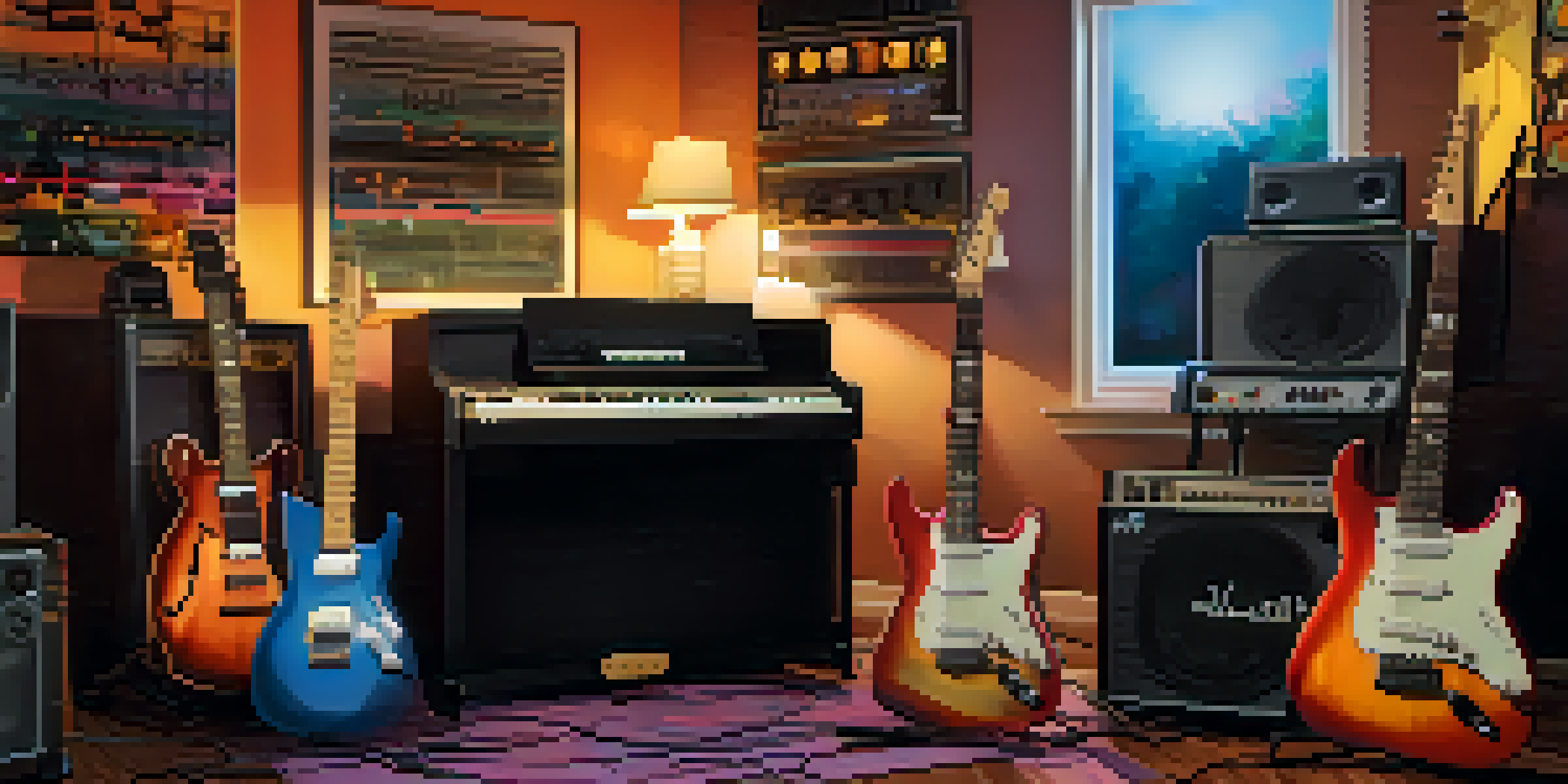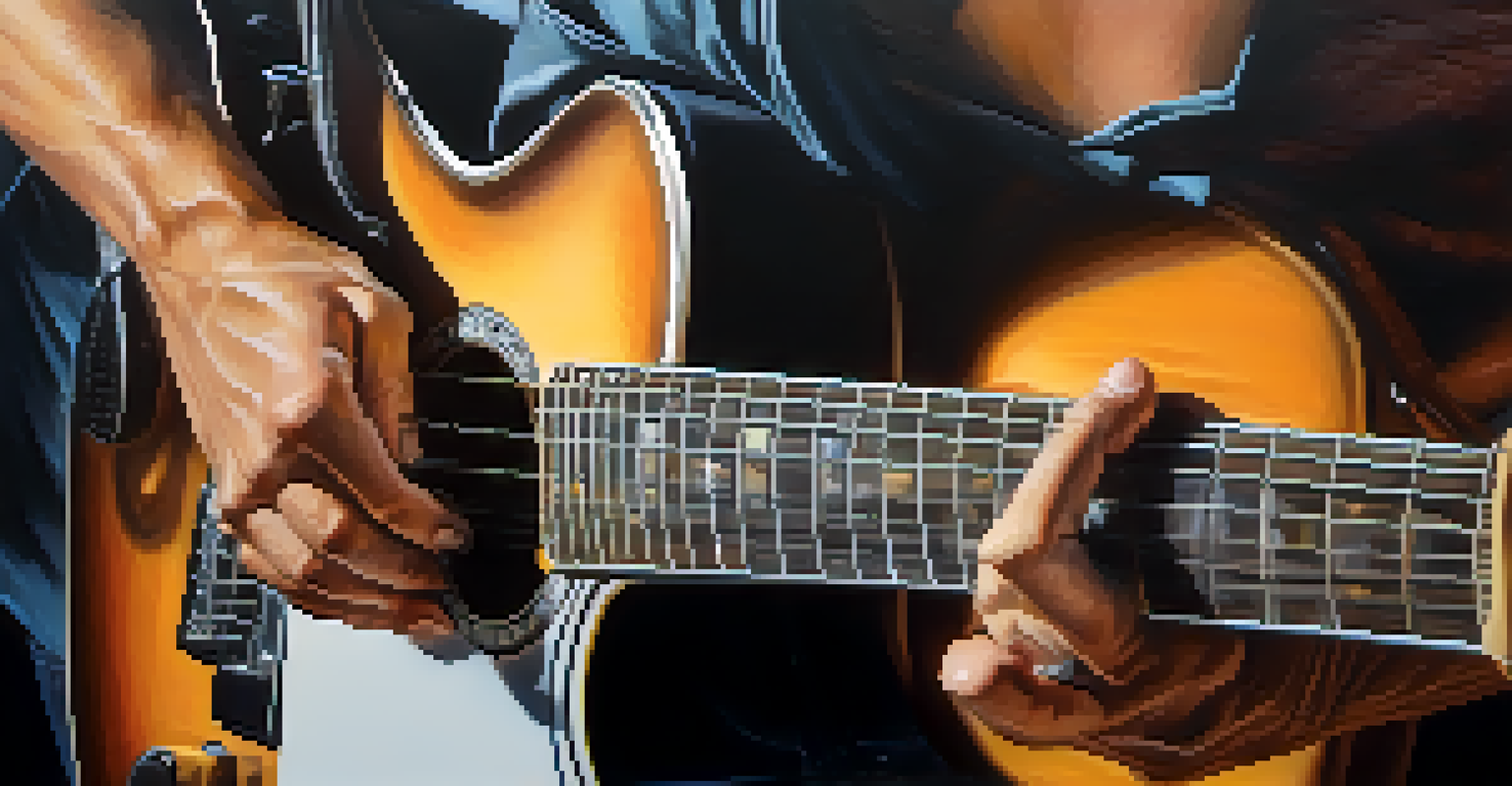Layering Guitar Tracks: Tips for a Richer Sound

Understanding the Importance of Layering Guitar Tracks
Layering guitar tracks is a fundamental technique in music production that adds depth and richness to a song. When done correctly, it creates a fuller sound that can engage listeners and elevate the overall feel of the music. Think of it like adding spices to a dish; each layer enhances the flavor, making the final product more enjoyable.
Music is the shorthand of emotion.
By using different guitar parts, such as rhythm and lead lines, you can create a sonic landscape that captures attention. Imagine a lush forest where every tree represents a unique guitar track, contributing to a vibrant ecosystem of sound. This is the essence of layering – each part complements the others while standing out in its own right.
Ultimately, mastering the art of layering can transform a simple guitar melody into an expansive audio experience. It encourages creativity and experimentation, allowing you to explore different textures and dynamics within your music. So, let’s dive into some practical tips to help you layer effectively!
Start with a Strong Foundation: Rhythm Guitars
The backbone of any layered guitar track is the rhythm guitar. This is where you establish the core chords and groove that will support your entire arrangement. Think of it as the sturdy foundation of a house; without it, everything else could crumble.

When recording rhythm guitars, consider using different guitar tones or techniques. For example, one track might feature a clean tone, while another employs a crunchy overdrive. This contrast adds richness and helps each part stand out, giving your mix a more dynamic feel.
Layering Creates Rich Soundscapes
Layering guitar tracks adds depth and richness, transforming simple melodies into expansive audio experiences.
Additionally, pay attention to the placement of your rhythm tracks in the stereo field. Spreading them across the left and right channels can create a sense of space, making your overall sound more inviting and immersive. The goal is to make listeners feel enveloped in your music.
Layering Melodies: Adding Lead Guitar Lines
Once your rhythm guitars are in place, it's time to think about the lead lines. These melodic parts can add excitement and emotion to your track, acting as the focal point that draws listeners in. Imagine the lead guitar as the voice in a conversation; it should capture attention and convey the message of the song.
The guitar is a miniature orchestra in itself.
When layering lead guitar lines, consider using harmonies or counter-melodies. This creates a richer texture and adds depth to your composition. For instance, if your lead guitar plays a melody, try harmonizing it a third or fifth above; the result can be breathtaking.
Don’t shy away from experimenting with different effects, like delay or reverb, to enhance your lead lines. These effects can create a sense of space and movement, making your melodies feel more dynamic. Remember, the lead guitar should complement the rhythm while still being a standout element in the mix.
Experimenting with Different Guitar Tones and Effects
Guitar layering isn’t just about playing different parts; it’s also about exploring various tones and effects. Each guitar has its unique voice, and combining them can lead to a rich and textured sound. Think of it like an artist mixing colors on a palette; the more shades you introduce, the more vibrant the final artwork will be.
Consider using different pickups, amps, or even guitars to achieve a diverse range of tones. For example, pairing a bright, jangly guitar with a thicker, heavier one can create a compelling contrast. This dichotomy can enhance the emotional impact of your piece.
Rhythm Guitars Establish Foundation
A strong rhythm guitar forms the backbone of a track, supporting the entire arrangement and enhancing its groove.
In addition, don’t hesitate to incorporate effects like chorus, phaser, or distortion to add character to your layers. These effects can transform your sound, lending it a unique personality. Just remember to maintain balance; too many effects can muddy the mix, so use them judiciously.
The Role of Arrangement in Layering Guitar Tracks
A well-thought-out arrangement is crucial when layering guitar tracks. It helps in determining when and how each part will enter and exit the mix, creating a cohesive and engaging listening experience. Think of your arrangement as a roadmap; it guides the listener through the musical journey you’ve crafted.
Pay attention to dynamics and how they influence the emotional arc of your song. For instance, you might start with just the rhythm guitar and gradually introduce lead lines or additional layers as the song builds. This creates tension and release, keeping listeners engaged throughout.
Also, consider the sections of your song and how different layers can enhance them. A chorus may benefit from fuller layers, while verses might feel more intimate with stripped-back instrumentation. This strategic layering can elevate your track and make each section feel distinct yet connected.
Using Panning to Create Space in Your Mix
Panning is a vital tool in the mixing process that can greatly enhance the layering of guitar tracks. By positioning different guitar parts across the stereo field, you can create a sense of space and dimension in your sound. Imagine a concert where each musician is placed strategically on stage; this layout can make the performance feel more immersive.
When layering guitars, try panning rhythm guitars slightly left and right while keeping the lead guitar centered. This separation allows each part to breathe and prevents them from clashing. The result is a clear, spacious mix where every note can be heard distinctly.
Panning Enhances Mix Clarity
Strategic panning of guitar tracks creates space and dimension, ensuring each element can be distinctly heard in the mix.
However, be mindful of not overdoing it; too much panning can create an unbalanced mix. Aim for a natural feel, where everything sits comfortably within the stereo image. A well-panned mix will invite listeners in, making them feel as if they’re part of the performance.
Mixing Tips for a Polished Layered Guitar Sound
Once you’ve layered your guitar tracks, the next step is mixing them for a polished final product. Start by adjusting the volume levels of each track to ensure that no single part overpowers the others. Think of it as balancing a scale; every element should contribute equally to the overall sound.
Consider using EQ to carve out space for each guitar track. By boosting certain frequencies and cutting others, you can help each layer shine without causing muddiness. For instance, if one guitar has a lot of low-end, you might reduce the lows on another to create clarity.

Lastly, don’t forget about compression. It can help control the dynamics of your layered guitars, ensuring a consistent sound throughout your track. A well-mixed guitar arrangement can leave a lasting impression, so take your time to refine it until it feels just right.
Final Thoughts on Layering Guitar Tracks
Layering guitar tracks is a rewarding process that can greatly enhance your music's depth and richness. By understanding the fundamentals and implementing the tips discussed, you can create a sound that resonates with listeners. It’s about experimenting, finding what works, and allowing your creativity to flourish.
Remember that each track you layer contributes to the whole, so approach each element thoughtfully. As you practice and refine your skills, you’ll discover new ways to express your musical ideas and develop your unique sound.
So grab your guitar, start layering, and watch your music come to life. The journey of sound exploration is just beginning, and with each layer, you’ll find new dimensions to your artistry.